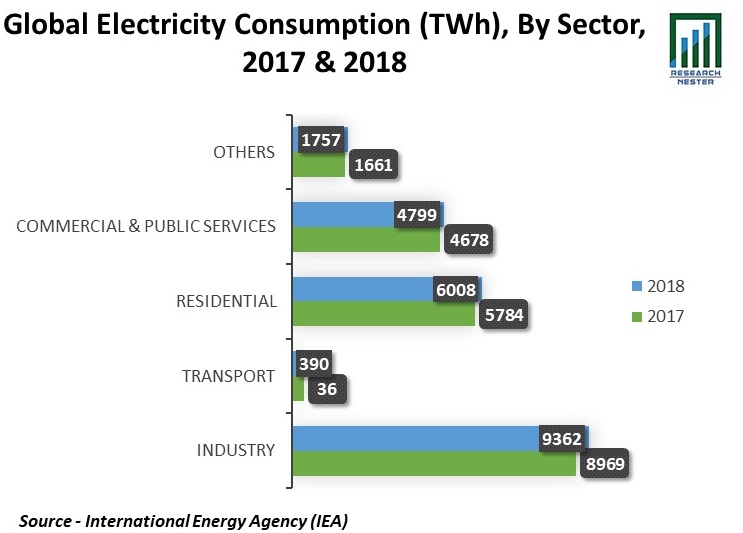Hydropower Market Trends
Growth Drivers
- Rising Global Energy Needs –As per the expected data, the world population is expected to reach 9.8 Billion by the end of 2050, energy needs are rising globally. Hydropower is a dependable form of energy that can deliver a consistent supply of electricity even when other energy sources are disrupted. As a result, it is an appealing alternative for countries seeking to improve their energy security.
- Rising Demand for Alternative Source of Energy– Hydropower may be utilized to preserve energy by preserving water uphill (as in dams) when energy demand is low and discharging it to create electricity when demand is high. This can assist to solve the periodic nature of other alternative power sources such as wind and solar, rendering hydropower as an essential component of power systems. For instance, hydropower systems generated over 4400 TWh of energy in 2020 globally.
- Increasing Reliance on Clean Energy Sources –With rising global warming and focus on sustainable development by governments globally, hydropower has been a strong pillar in supporting the clean energy transition. In fact, hydropower units produce more electricity than other form of renewable energy (except nuclear) such as wind and solar combined. Furthermore, the other source of energy based on fossil fuels emits large amount of carbon dioxide, that is further expected to boost the growth of the market. According to the International Energy Agency, coal accounted for more than 40 percent of the overall growth in the global carbon dioxide emissions in the year 2021.
- Boost to the Economy – Hydropower projects are often major projects that require intensive capital and human effort to be completed. Such projects often attract investment from many sources, as well as provide employment to many people who help in its construction and upkeep. Hence, they provide jobs and investment opportunities to the people. According to the estimates, nearly USD 2000 to 5000 million is required to build a dam that can serve many purposes.
- Increasing Need for Cheaper Cost of Energy: Hydropower generation rates have been falling in recent years as a result of technical advances, efficiency gains, and economies of scale. It has allowed hydropower to become an affordable source of energy. Moreover, in terms of upkeep and operations, hydropower is cheaper than other sources of electricity. Although expenses are bound to be there in any huge energy producing facility, the long-term nature of hydropower plants makes expenses bearable by reducing huge one-time expenses and spreading them over a longer spam of time. Hydropower does not get affected by changes in fuel prices and hence remains stable in terms of power generation costs. As per the International Hydrogen Association, the world’s average cost of electricity from hydrogen projects in the year 2018 accounted to only USD 0.047 per Kwh.
Challenges
- Environmental and Social Consequences: Major hydropower projects can have considerable ecological as well as social consequences, such as community displacement, biodiversity loss, and ecosystem disturbance. These effects may be reduced by diligent project design and administration, yet they may also increase the cost and complexities of hydropower projects. Therefore, it is anticipated to restrain the growth of the global hydropower market in the upcoming years.
- High Capital Investment
- Geographically Limited as it Requires Large Water Bodies to Be Constructed
Hydropower Market : Key Insight
In 2018, the world’s total energy supply was 14282 Mtoe, wherein the highest share in terms of source was captured by oil, accounting for 31.6%, followed by coal (26.9%), natural gas (22.8%), biofuels and waste (9.3%), nuclear (4.9%), hydro (2.5%), and other (2.0%). Where there was an increase in energy demand in 2018, the year 2019 witnessed slow growth as the energy efficiency improved owing to decline in the demand for cooling and heating. However, in 2020, the electricity demand decreased by 2.5% in the first quarter of 2020 due to the outbreak of Coronavirus resulting in government imposed shutdowns in order to limit the spread of the virus, which was further followed by shutdown of numerous business operations impacting their growth. This also resulted in decline of 5.8% in the worldwide CO2 emissions which was recorded to be five times larger than the one recorded during the global financial crisis in 2009. However, in 2021, the demand for oil, gas and coal is estimated to witness growth, which is further projected to create opportunities for market growth. Moreover, rising environment degradation and awareness related to climate change is motivating many key players to employ sustainable energy strategies and invest significantly in environment-friendly power generation technologies with an aim to promote sustainable development among various nations around the world. Such factors are anticipated to promote the growth of the market in upcoming years.
|
Base Year |
2024 |
|
Forecast Year |
2025-2037 |
|
CAGR |
5.4% |
|
Base Year Market Size (2024) |
USD 278.57 billion |
|
Forecast Year Market Size (2037) |
USD 542.97 billion |
|
Regional Scope |
|

